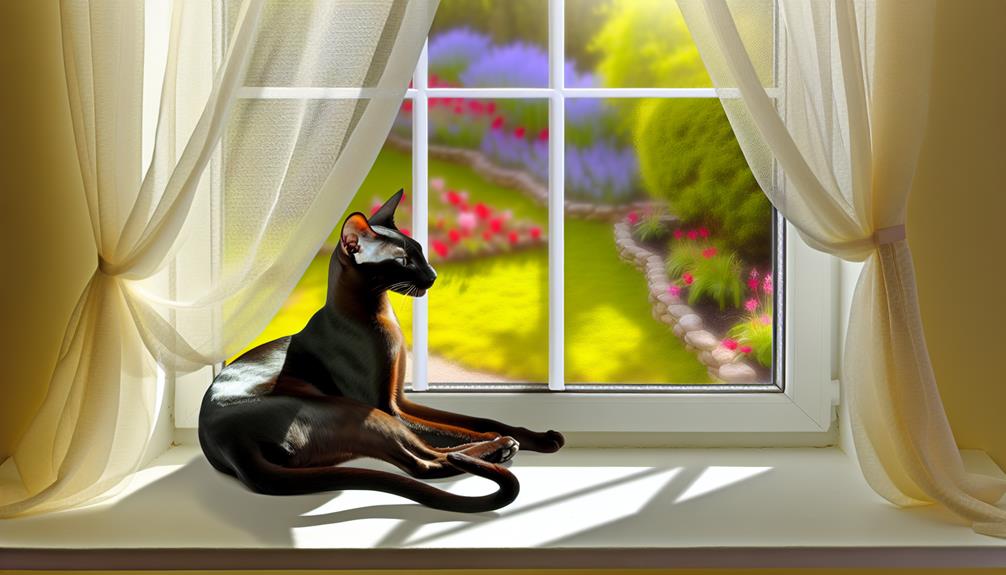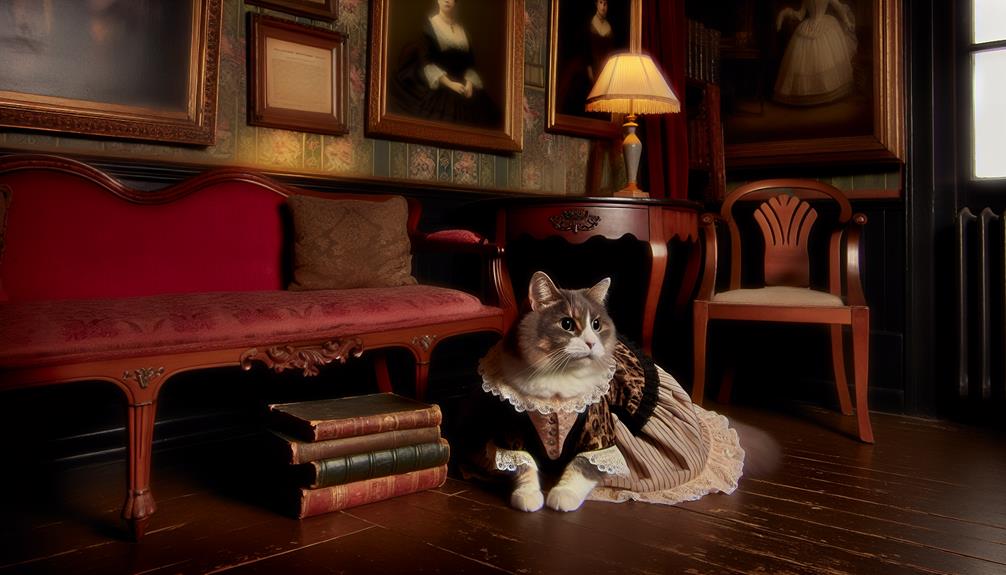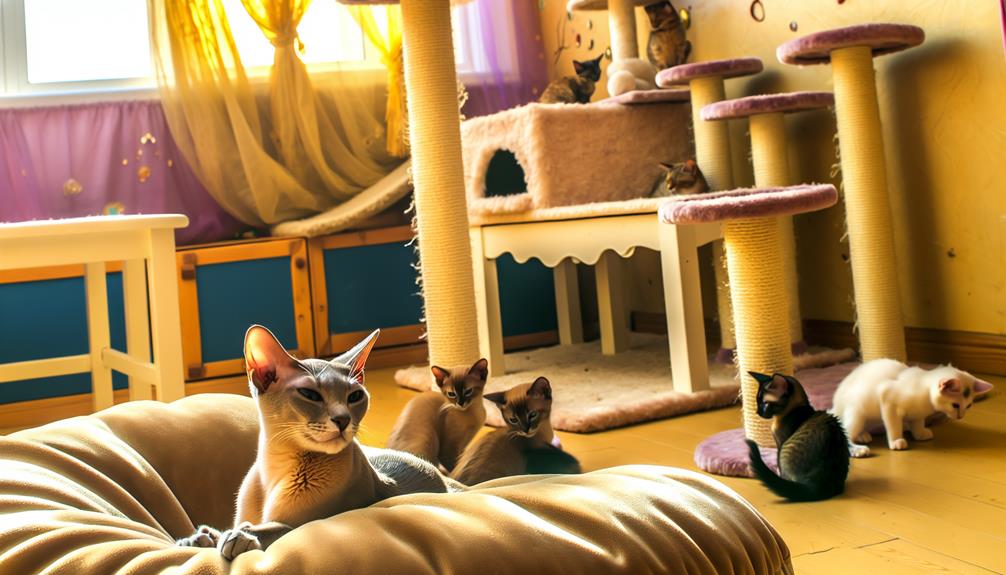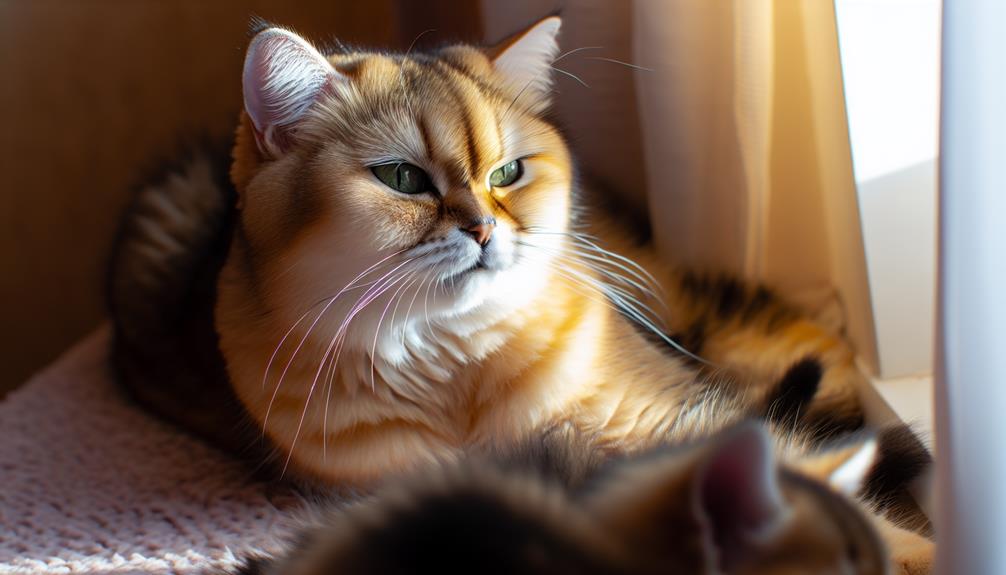When discussing female cats, the terms "queen" and "molly" might surprise you, as they signify different stages and roles in a cat's life. A "queen" is a breeding-age, unspayed female in heat, displaying specific behaviors to attract mates. On the other hand, a "molly" is a more general term for any female cat, often signifying those not currently in heat. These distinctions aren't just cute labels; they reflect important aspects of feline behavior and biology. Curious about how these terms came about and what they mean for cat owners? Let's explore further.
Queen
In the domain of feline terminology, a female cat is often referred to as a "queen," particularly when she's unspayed and of breeding age. This term isn't just a whimsical label; it reflects the regal and commanding presence these cats often exhibit. Understanding the behavior and communication of a queen is essential if you want to provide her with the best care.
Queens exhibit distinct cat behaviors, especially when they're in heat. You might notice increased vocalization, which is a form of feline communication designed to attract potential mates. These vocalizations are often accompanied by more intense grooming and rubbing against objects, marking their territory with scent glands located on their face and body.
When a queen is pregnant or nursing, her behavior changes to become more protective and nurturing. She might seek out quiet, secluded spaces to give birth and care for her kittens. During this period, her communication shifts to softer, more frequent purring and chirping sounds, which help to comfort and guide her kittens.
It's also important to recognize a queen's social dynamics within a multi-cat household. Queens can be more territorial, asserting dominance over other cats. This is a natural aspect of feline behavior, driven by their need to secure resources for themselves and their offspring. Observing these interactions can give you valuable insights into their social hierarchy and individual personalities.
Molly
Although the term "queen" is well-known, "molly" is another term used to describe a female cat, particularly one that isn't currently in heat or hasn't bred. Understanding the molly characteristics can help you better appreciate and care for these unique feline companions.
A molly exhibits behaviors and traits distinct from both male cats and those female cats that are in heat or have bred. For instance, molly behavior tends to be more stable and less territorial compared to that of a queen in heat. These cats often exhibit a calm demeanor, making them delightful companions in a household setting.
Here's a quick comparison to help illustrate key molly characteristics:
| Characteristic | Molly | Queen |
|---|---|---|
| Reproductive Status | Not in heat, hasn't bred | In heat or has bred |
| Behavior | Stable, calm | Territorial, can be aggressive |
| Activity Level | Moderate | Varies, often increased |
| Interaction with Other Cats | Generally friendly | Can be aggressive or aloof |
Molly behavior can also include a lower propensity for marking territory, reducing the likelihood of unwanted spraying. This can make mollies more manageable in a multi-cat household. Additionally, mollies are typically more receptive to human interaction, making them ideal for families or individuals seeking a pet that enjoys companionship without the complications of reproductive behavior.
She-Cat

When it comes to understanding feline terminology, the term "she-cat" is a straightforward one used to describe any female cat, regardless of her reproductive status. Whether she's a kitten, adult, or senior, the term applies universally. Knowing this helps you communicate more effectively about your feline companion, especially when discussing her behavior and health.
She-cat behavior is distinct in several ways. Female cats are often more territorial than their male counterparts and can be particularly protective of their space. You might notice your she-cat marking her territory more frequently or being more selective about her companions. Behavioral changes can also occur depending on her reproductive cycle. For instance, an unspayed she-cat might exhibit signs of being in heat, such as increased vocalization, restlessness, and affectionate behavior.
When it comes to she-cat health, there are certain considerations to keep in mind. She-cats are susceptible to specific health issues, such as ovarian cysts or uterine infections, particularly if they are not spayed. Regular veterinary check-ups are crucial to monitor and maintain her overall health. Additionally, she-cats are prone to urinary tract infections, which can manifest as frequent urination or discomfort.
Understanding these nuances in she-cat behavior and health can help you provide better care for your female feline. Pay attention to any changes in her behavior or physical condition, as these could be early signs of health issues. By staying informed and proactive, you can guarantee your she-cat leads a happy, healthy life.
Terminology in Breeding
Beyond understanding general she-cat behavior and health, it's equally important to grasp specific terminology used in breeding contexts. When you're delving into the world of cat breeding, knowing the right terms can be incredibly helpful for clear and effective communication. Let's break down some key terms related to breeding behavior and reproductive cycles that you might encounter.
- Queen: In the domain of breeding, a mature female cat that is actively used for reproduction is referred to as a "queen." This term highlights her role in the breeding hierarchy and her reproductive status. Queens are central to the breeding process due to their ability to produce litters.
- Estrus (Heat): The reproductive cycle in female cats involves phases, with estrus being the period when she is sexually receptive. This phase, commonly known as being "in heat," can last from a few days to two weeks. During estrus, you'll notice specific breeding behaviors such as increased vocalization, restlessness, and a raised hindquarters posture.
- Gestation: Once successful mating has occurred, the queen enters a gestation period, which lasts about 63 to 67 days. During this time, it's essential to provide ideal care to guarantee the health of both the queen and the developing kittens. Monitoring her diet, comfort, and health closely will make a significant difference.
Understanding these terms will not only deepen your knowledge but also enable you to communicate more effectively with veterinarians and fellow breeders. Paying attention to the queen's reproductive cycles and breeding behavior guarantees a healthier and more controlled breeding process, fostering a compassionate and responsible approach to cat breeding.
Historical Context

Understanding the term for a female cat requires considering ancient domestication practices, where cats were revered and often had specific roles based on their gender. Over centuries, gender-specific terminology evolved, influenced by various cultures that held cats in high regard. You'll find that the cultural significance of cats, especially female ones, has shaped not just language, but also societal attitudes towards these fascinating animals.
Ancient Domestication Practices
The domestication of cats dates back thousands of years, with evidence suggesting that ancient civilizations, such as those in Egypt, were among the first to welcome these intriguing creatures into their homes. Cats played significant roles in these societies, not just as pets but as symbols and participants in various rituals.
Ancient Egyptians revered cats for their grace and hunting prowess. They believed cats possessed spiritual qualities, linking them to gods and goddesses. This feline symbolism was deeply embedded in their culture and religious practices.
To understand the ancient domestication practices, consider these key points:
- Ancient Rituals: Cats were often involved in sacred rituals, believed to bring good fortune and protect against evil spirits. They were associated with deities like Bastet, the goddess of home, fertility, and childbirth.
- Feline Symbolism: Cats symbolized protection and were thought to guard homes and temples from vermin and supernatural threats. Their depiction in art and literature underscored their revered status.
- Domestic Integration: Cats were integrated into daily life, often depicted in family settings and hunting scenes, emphasizing their dual role as companions and protectors.
Through these practices, cats became an integral part of ancient societies, shaping human-feline relationships for millennia.
Gender-Specific Terminology Evolution
Throughout history, the terminology used to describe female cats has evolved alongside human linguistic development and cultural shifts. You'll notice that the term "queen" is commonly used today, but this wasn't always the case. Early references to female cats varied greatly depending on the region and language, reflecting a rich tapestry of linguistic diversity.
In medieval Europe, for example, female cats were often referred to as "she-cats," a straightforward designation based on gender identity. This term highlighted the importance of distinguishing between male and female cats, especially in breeding contexts. Over time, the language shifted, and more affectionate terms like "molly" emerged, though their precise origins remain somewhat obscure.
By the 19th century, the term "queen" became more widespread, likely influenced by the role of female cats in breeding and their regal demeanor during pregnancy and nurturing. This evolution in terminology isn't just about words; it's also about how human societies have perceived and valued gender roles in animals.
Understanding this progression helps you appreciate the linguistic diversity and cultural nuances that shape our current vocabulary. It's a reflection of how language evolves in tandem with societal attitudes towards gender identity and animal companionship.
Cultural Significance of Cats
Cats have held significant cultural roles throughout history, often revered and sometimes feared. You'll find that their presence spans various civilizations, each attributing unique meanings to these enigmatic creatures. For instance, in ancient Egypt, cats were considered sacred and linked to the goddess Bastet, embodying protection and fertility. Their symbolic importance was so profound that harming a cat could result in severe punishments.
In medieval Europe, however, cats faced a darker period. They were often associated with witchcraft and the supernatural, leading to widespread persecution. This shift in cat symbolism highlights how societal beliefs can drastically affect an animal's status.
In East Asian cultures, cats have historically been seen as symbols of good fortune and protection. The famous "Maneki Neko" or beckoning cat, often seen in businesses, is believed to bring prosperity and happiness.
Here are three key points to remember about the cultural significance of cats:
- Sacred Symbols: Cats in ancient Egypt were revered, embodying divine protection and fertility.
- Witchcraft Associations: Medieval Europe saw cats as ominous, linking them to the supernatural.
- Fortune and Prosperity: East Asian cultures view cats as harbingers of good luck and protection.
Understanding feline mythology and cat symbolism across cultures reveals the profound impact these animals have had on human history.
Common Misconceptions
You might be surprised to learn that many people mistakenly believe all female cats are simply called "queens." While it's true that a breeding female cat is referred to as a queen, this term doesn't universally apply to all female cats. This is one of the most common misconceptions about terminology in the feline world. Understanding the precise terms can clear up any confusion and help you communicate more accurately about your feline friends.
One prevalent female cat myth is that "queen" is an all-encompassing term. In reality, only female cats that are actively breeding or are capable of breeding are called queens. If a female cat is spayed or not involved in breeding activities, she's simply referred to as a "female cat." It's akin to how not all adult human females are referred to as mothers; the term "queen" implies a specific role and condition.
Another common misconception is that the term "queen" denotes a certain behavior or status among cats. While it might conjure images of regal, dominant behavior, the term is purely biological. It doesn't imply that the cat will act more dominantly or possess any special social status among other cats.
Moreover, some people might think that female cats have different names based on their age, much like how male cats can be called "toms" or "gib" (neutered males). However, this isn't the case. Female cats are simply called "female cats," regardless of their age or reproductive status unless they are breeding, in which case "queen" is appropriate.
Clearing up these misconceptions helps foster a better understanding and appreciation of our feline companions.
Fun Facts

Understanding the correct terminology when it comes to female cats can certainly clear up a lot of confusion. But let's explore some captivating fun facts about these fascinating creatures. Female cats, or queens, have their own set of unique behaviors and health considerations that set them apart from their male counterparts.
- Female Cat Behavior During Heat: Female cats experience a reproductive cycle known as estrus, commonly referred to as "heat." During this period, you'll notice a notable change in behavior. Queens become more affectionate, vocal, and may even roll on the ground. This behavior is an instinctive way to attract male cats for mating. Unlike dogs, cats are induced ovulators, meaning ovulation occurs only after mating.
- Health Benefits of Spaying: Spaying your female cat has considerable health benefits. It greatly reduces the risk of uterine infections and breast tumors, which are malignant or cancerous in about 90% of cats. Additionally, spaying eliminates the risk of ovarian cancer and prevents the often problematic behaviors associated with heat cycles.
- Maternal Instincts: Female cats exhibit strong maternal instincts. When they have kittens, queens will be highly protective and attentive. They'll groom their kittens meticulously and teach them essential survival skills. Notably, mother cats also communicate with their kittens through a series of purrs and meows, a behavior that promotes bonding and safeguards the kittens' well-being.
Understanding these aspects of female cat behavior and health allows you to provide better care for your feline companion. It's not just about knowing the right terms; it's about appreciating the unique qualities that make your queen so special.
Conclusion
Understanding the terminology for female cats can enrich your appreciation of their behaviors and roles. Imagine your neighbor's cat, Luna. When she's in heat, she's a "queen," seeking a mate. When she's not, she's a "molly," calm and affectionate. Knowing these terms, you can better understand and care for your feline companions. It's fascinating how simple terms like "queen" and "molly" reveal so much about our beloved pets' lives and behaviors.
